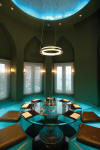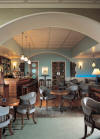|
|
the-south-asian.com January - March 2009 |
|
|||
|
Five Main Targets - CST
Taj
- Mumbai's
|
|
||||
|
Mumbai
26/11 - Five Main Targets Taj Tower & Taj Mahal Hotel – the pride of Mumbai attacked The Taj Mahal Palace HotelThe majestic 105-year-old Taj Mahal hotel on Mumbai’s waterfront has been the face of Bombay, now Mumbai, and also India’s best-known hotel. There was no Gateway of India at the time it was built – or the adjacent Taj Tower, which came about only in the 70s. The six-storeyed Taj Mahal hotel was one of Jamsetji Tata’s many dreams, who died the year after it opened its doors to its guests. The very latest in western technology was used in the construction of the Taj, which has been the epitome of Indian hospitality, and the flagship of a chain of luxury hotels. The common perception of Taj Mahal hotel - that it is all about wealth and glamour – maybe partially true but not entirely. What is not common knowledge is that a large portion of the hotel’s post-tax profits go to a number of Mumbai’s charities. This has been the norm for generations. L-R: The poolside where the first shots were fired; Wasabi Restaurant; and the Harbour BarWhen the terrorists stormed into the Taj Mahal Hotel – they attacked not just an icon, a symbol, a heritage – but the city’s pride. The first shots were fired near the swimming pool before the gunmen swarmed into the hotel’s lobby and restaurants on a killing spree, and then dispersed into its maze of corridors on various floors to round up more hostages. The Shamiana at Taj Tower, and the Golden Dragon and the Harbour Bar at the Taj Mahal were the first to come under firing attack. The commandos of the NSG who began operations in the early hours of November 27, were able to secure the Taj Tower the following day – but the battle at the Taj Mahal was to last another day, where the sixth floor was gutted, and fires raged throughout the hotel at different locations at different times. The end came for the terrorists on the morning of November 29, when all four were killed and their bodies found in the Harbour Bar, which faces the same waters that brought the terrorists ashore with the sole agenda of slaughter. At the time of the attack, the hotels had 450 guests in the hotel and many visitors in its various hotels. Thirty-one people lost their lives at the Taj – including Major Unnikrishnan of the elite NSG, and twelve staff of the Taj Hotels. Apart from the immense damage the Taj Mahal suffered, the hotel will also have to restore a part of its prized collection of contemporary art, some of which got damaged. The Taj Tower re-opened on December 21, but it will be a while before the Taj Mahal Hotel, which took the brunt of the attack, is restored.
RATAN N. TATA ON THE RE-OPENING OF TAJ TOWER DEC 21, 2008 "We have heard many stories of magnificent courage and selfless service,
not just in the acts of the police and security forces, but also by the
staff of the hotel. They have set new standards that we can only hope to
aspire to". The attack we faced on 26/11 was not just on an attack on Taj, it was an attack on Mumbai and in a way on India. I have said from that first day, what it did achieve was that it united all of us in one common cause. We cannot bring back the lives of the people who died in that unfortunate terrible act. We can only condole their families and express our grief – those lives were lost not just in this hotel, but with the police, commandos and innocent people at the railway station. It was an attack on a peaceful community, a city with different religions and was indiscriminate. Apart from those who died, those who were injured received equally the kind of personal attention from selfless doctors, from citizens whom we never know, people who carried them to the hospital and they did this because it was an attack on the city. Here in the Taj we had tremendous and unprecedented display of spirit, a spirit to protect our guests, to protect each other and we have given a fitting tribute to those who were there that night. After the event took place when we went through the property, walking over crushed glass and charred doors it was as though a war had taken place and indeed a war took place here. It was that same spirit that has converted this part of building from what it was, by working day and night, so that we could open today. By opening today the Tower block, we send a strong message that within a month, we are up and running and that this hotel would take its place as one of the marks of the city. When we open the heritage wing, and we will do whatever it takes to get back its old glory, it would be more modern or better than it was and that it will be the glory and icon of the city again. And when we do, we will send a stronger message, a message that strongly resonates among all of us - that we can be hurt but we cannot be knocked down. The Taj I hope will stand for another 100 years or more and stand as a living tribute to the tenacity of our people –both in the city and this company and that we can rise to any occasion and that spirit is something that I like to pay tremendous tribute to all those people in the hotel that have paid with their lives, to all those who played a role in saving lives and returning this hotel to what it is. My true debt of gratitude goes to all of them.
The Re-opening of Taj Tower At 7:00 p.m. on Sunday, 21st December, the first guests,
since that tragic night of 26/11, checked in at The Taj Tower. Five of its
restaurants welcomed the diners. The Tower wing had reopened 24 days after
the terrorist attack on the city of Mumbai. As a result of the attacks, the Taj has launched a fund to
support all the victims of the attacks, not just at The Taj Mahal Palace and
Tower, but also across the entire city.
|
|||||
|
Copyright © 2000 - 2009 [the-south-asian.com]. Intellectual Property. All rights reserved. |
|||||



